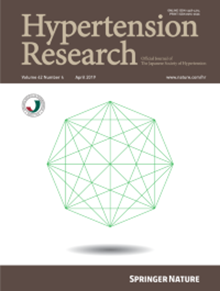在高盐和低乳制品饮食人群中,乳制品消费与收缩压和高血压呈部分负相关:来自Iwaki健康促进项目的横断面数据分析。
IF 4.3
2区 医学
Q1 PERIPHERAL VASCULAR DISEASE
引用次数: 0
摘要
日本的高血压患病率仍然很高,这是由于典型的日本饮食中含盐量很高。乳制品类食品可以降低血压和高血压的风险。然而,日本的乳制品消费量很低,乳制品摄入量与血压之间的关系或乳制品影响血压的机制尚不完全清楚。这项横断面研究是作为日本青森市磐城健康促进项目的一部分进行的。2015年6月,共有1071名参与者参加了年度体检。通过调整多元线性和逻辑回归分析来分析乳制品消费与血压或高血压风险之间的关系。还进行了全面的血液生物标志物测量。全脂和高脂乳制品消费与所有参与者的收缩压(SBP)呈显著负相关(β = -0.0213, P = 0.044),与未使用降压药的收缩压和收缩期高血压风险呈显著负相关(β = -0.0306, P = 0.011;OR = 0.9927, P = 0.016;分别)。三种与磷代谢相关的血液生物标志物(无机磷、完整甲状旁腺激素和白细胞介素-6)与乳制品消费和收缩压相关。在高盐低乳制品消费的日本人群中,乳制品消费与收缩压和高血压风险呈部分负相关。血液生物标志物分析表明,磷代谢与乳制品消费和血压之间的关系有关。本文章由计算机程序翻译,如有差异,请以英文原文为准。

Dairy consumption has a partial inverse association with systolic blood pressure and hypertension in populations with high salt and low dairy diets: cross-sectional data analysis from the Iwaki Health Promotion Project
The prevalence of hypertension in Japan remains high, owing to the high salt content of the typical Japanese diet. Dairy-based foods may reduce blood pressure and hypertension risk. However, dairy consumption is low in Japan, and the relationships between dairy intake and blood pressure or the mechanisms by which dairy products affect blood pressure are not fully understood. This cross-sectional study was conducted as part of the Iwaki Health Promotion Project in Aomori, Japan. A total of 1071 participants were included from those who underwent annual medical checkups in June 2015. Adjusted multivariate linear and logistic regression analyses were performed to analyze the relationships between dairy consumption and blood pressure or hypertension risk. Comprehensive blood biomarker measurements were also performed. Whole- and high-fat dairy consumption was found to have significant inverse associations with systolic blood pressure (SBP) for all participants (β = –0.0213, P = 0.044) and with SBP and systolic hypertension risk for non-users of antihypertensive medicines (β = –0.0306, P = 0.011; and OR = 0.9927, P = 0.016; respectively). Three blood biomarkers related to phosphorus metabolism (inorganic phosphorus, intact parathyroid hormone, and interleukin-6) were associated with both dairy consumption and SBP. Dairy consumption had a partial inverse association with SBP and hypertension risk in a Japanese population with high salt and low dairy consumption. Analysis of blood biomarkers suggested that phosphorus metabolism is involved in the associations between dairy consumption and blood pressure.
求助全文
通过发布文献求助,成功后即可免费获取论文全文。
去求助
来源期刊

Hypertension Research
医学-外周血管病
CiteScore
7.40
自引率
16.70%
发文量
249
审稿时长
3-8 weeks
期刊介绍:
Hypertension Research is the official publication of the Japanese Society of Hypertension. The journal publishes papers reporting original clinical and experimental research that contribute to the advancement of knowledge in the field of hypertension and related cardiovascular diseases. The journal publishes Review Articles, Articles, Correspondence and Comments.
 求助内容:
求助内容: 应助结果提醒方式:
应助结果提醒方式:


